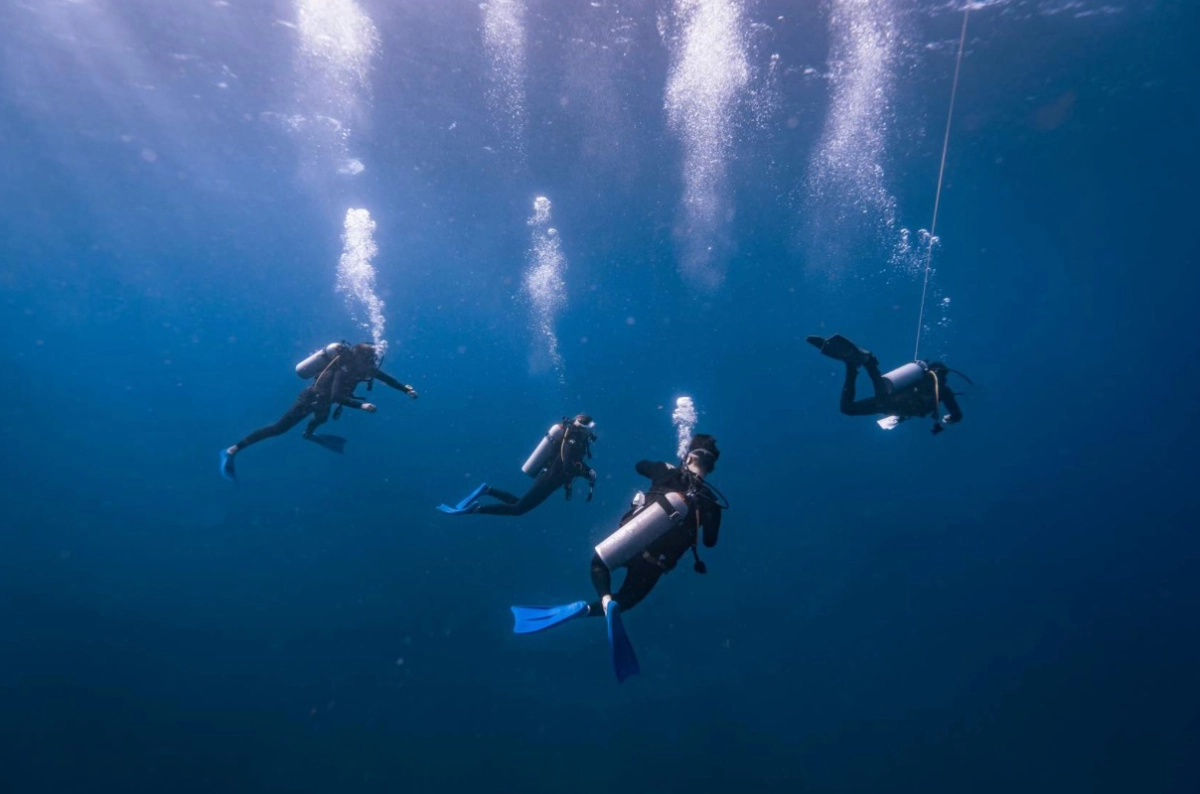Deep Diver
-
Introduction to Deep Diving
-
Preparing for Deep Diving
-
Deep Dive Planning
-
Deep Diving Techniques
-
Equipment for Deep Diving
-
Advanced Buoyancy Control
-
Conservation Awareness for Deep Diving
-
Deep Diver Exam1 Quiz
-
Deep Diver Training Dive 1
-
Deep Diver Training Dive 2
-
Deep Diver Training Dive 3
-
Deep Diver Training Dive 4
By the end of this lesson, you will be able to:
- Explain the importance of maintaining contact with your buddy
- Describe how to conduct deep diving descents and ascents
- Explain how gas consumption changes as you dive deeper
Buddy Contact
Buddy separation is of particular concern during deep dives because it can lead to the end of the dive. This is because often there is not enough gas and no stop time to find each other and continue the dive. To avoid becoming separated:
-
Maintain contact by staying close and keeping visual contact during descents and ascents. On the bottom, it helps to swim alongside each other.
-
If you’re leading the team, swim slowly and check with your buddy regularly.
-
Use physical contact to stay with your buddy, such as holding hands or hanging on to a BCD strap in low visibility.

Remember that if you lose contact with your buddy, search for them for one minute. If you have not found them after one minute, you should ascend to the surface and rejoin them there.
Descents and Ascents for Deep Dives
When diving and the bottom is visible, orienting yourself is usually straightforward. However, when you cannot see the bottom, it may be helpful to descend feet first. This position reduces vertigo and helps you stay oriented. Many divers find it easier to equalize in this position. Alternatively, you can descend with your head slightly above your feet in a ‘skydive’ position.
Buoyancy control is crucial for regulating your ascent and descent rate during diving. However, in some situations, such as diving in a current, it may become necessary to slow or stop your ascent or descent without losing contact with the line. Typically, you would hold onto the line, but if you need both hands free or your other hand is occupied, this may not be possible.
In such a scenario, there are two methods that you can use. Firstly, you can anchor your elbow on the line. This method is quick and decreases your speed. Still, it can be tiring and uncomfortable if you need to perform a task that requires more time and effort, like adjusting a weight system.
The second method involves wrapping your leg around the line and is primarily used for stopping. Once in position, you can remain there for several minutes if needed.

Safety Stops
Safety stops are a standard procedure in diving, particularly after diving at significant depths. These stops are essential because, as a diver descends into deeper waters, the increased pressure causes the body to absorb more nitrogen. Ascending too quickly without allowing time for the body to off-gas excess nitrogen can lead to decompression sickness.
By making a safety stop at shallower depths for a few minutes before ascending to the surface, divers allow their bodies to gradually release accumulated nitrogen. This reduces the risk of decompression sickness and ensures a safer return to the surface.
Whether it’s a routine safety stop or an emergency decompression stop, both play critical roles in ensuring the safety and well-being of divers. It’s important for divers to adhere to these procedures diligently to minimise the risks associated with deep-sea exploration.
Emergency Decompression Stops
Imagine you’ve been diving deep for an extended period, and suddenly, your dive computer starts flashing warnings that you have stayed too long at depth. Yikes, right? In this scenario, you need to take action fast.
Emergency decompression stops are necessary when a diver spends too long at depth, resulting in excess nitrogen buildup in the body. These stops are critical for avoiding serious health risks associated with decompression sickness, such as joint pain, numbness, dizziness, and, in severe cases, even paralysis or death.
If you are using a dive computer, it will provide you with guidance on the required stops you need to make during your dive. You should follow your dive computer until you have completed all your stops. However, if your computer has stopped functioning or you are not using one, you should take note of the following guidelines.
If you have exceeded your no-decompression limit by less than 5 minutes, stop at 5 meters for 8 minutes, and avoid diving for at least 6 hours. On the other hand, if you have exceeded your no-decompression limit by more than 5 minutes, you should extend your 5-meter stop to 15 minutes and avoid diving for at least 24 hours. It is essential to adhere to these guidelines to ensure your safety during and after your dive.
Buoyancy for Deep Dives
As you have already learned, ensuring that you are correctly weighted before diving is crucial. In other words, while wearing all your gear and with an empty BCD, you should float at eye level while holding a normal breath and slowly descend when you exhale. After adjusting for a full cylinder, add two kilograms. Remember that deep dives can cause your exposure suit to compress and lose buoyancy, which may result in more buoyancy loss. However, do not decrease the weight, or you may be too buoyant to make an effective safety stop at the end of the dive.
Adjusting your buoyancy regularly is essential to avoid sudden descents and ascents. Aim to be neutral buoyancy as you reach your desired depth. This also applies to reaching your safety stop during your ascent. By making slow descents, you can minimize the risk of experiencing mask, ear, sinus, or drysuit squeeze and prevent harm to marine organisms. A slow ascent is also recommended to reduce the likelihood of decompression illness.
You can learn more about improving your buoyancy on the NovoScuba Buoyancy course and Adventure Dive.
Breathing Techniques for Deep Diving
Maintaining a slow, deep and continuous breathing pattern while diving deep is crucial. Overexertion should be avoided since the gas becomes denser as you go deeper during deep dives, which requires more breathing energy. Breathing too quickly can cause shortness of breath, giving the feeling that the regulator is not providing enough gas. Avoiding any strenuous activity that can lead to rapid breathing is recommended.
Try taking deep, slow breaths from the abdomen to breathe efficiently during your dive. This technique allows you to fill your lungs from the bottom, which results in better gas exchange while using less energy. It is also the most relaxed way of breathing and can help you maintain optimal breathing techniques.
Gas Consumption
When it comes to deep dives, it’s important to remember that the deeper you go, the faster you’ll use your gas. This means that you need to plan your gas usage conservatively. Plan your turn pressure with enough gas for your return, ascent, safety stop, and reserve. Planning for a larger reserve than usual is always a good idea, as emergencies can arise quickly on deep dives.
In some cases, you may start your dive deep but finish shallow. Plan your turn pressure accordingly and assume you’ll ascend to a longer, extended shallow part of the dive. This will allow you to plan your gas usage and enjoy your dive.
It’s important to remember that low-on-gas or out-of-gas emergencies can become critical faster on a deep dive. To avoid this, make sure to check your remaining gas supply frequently. The deeper you dive, the more often you should check it.

